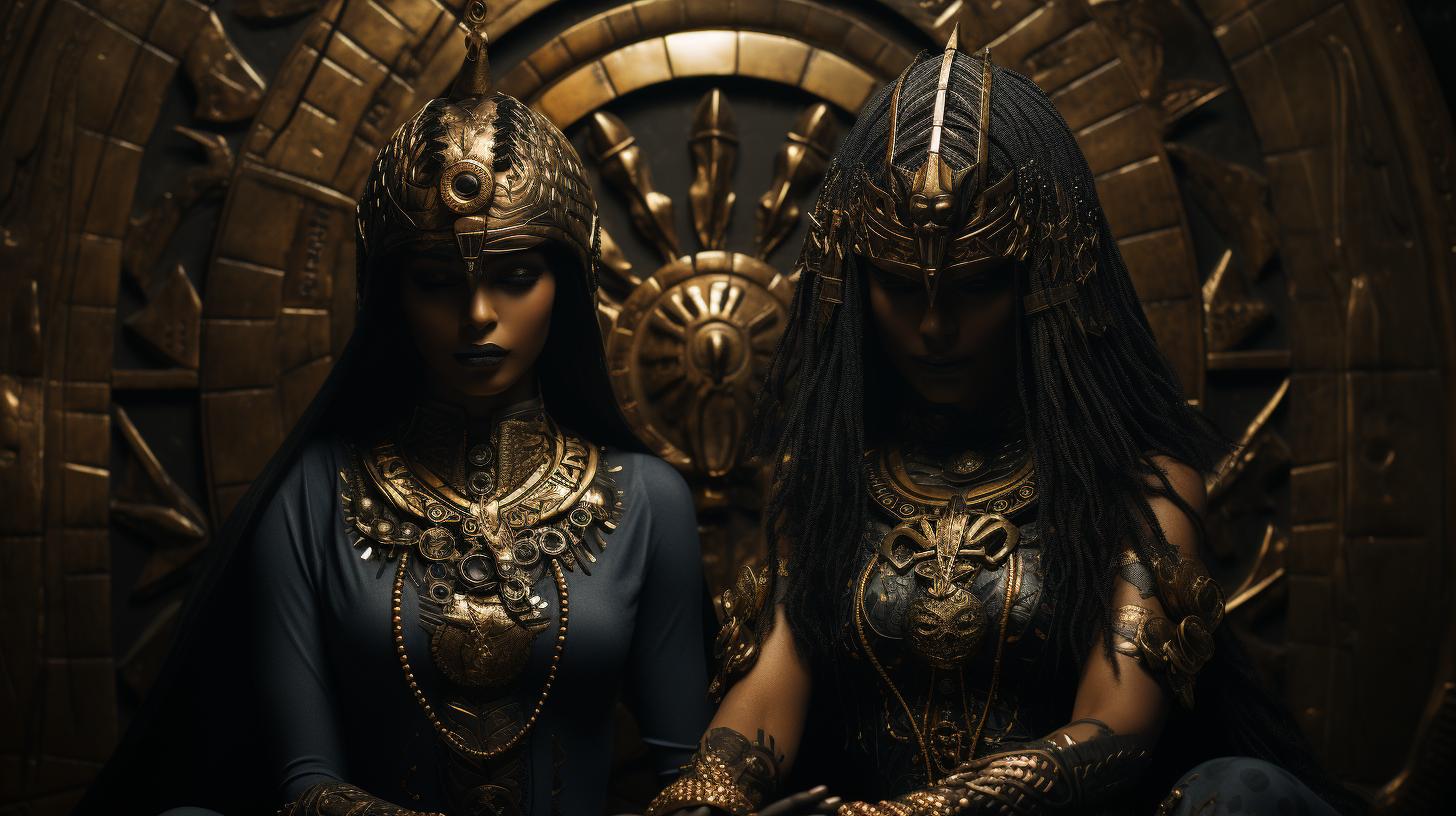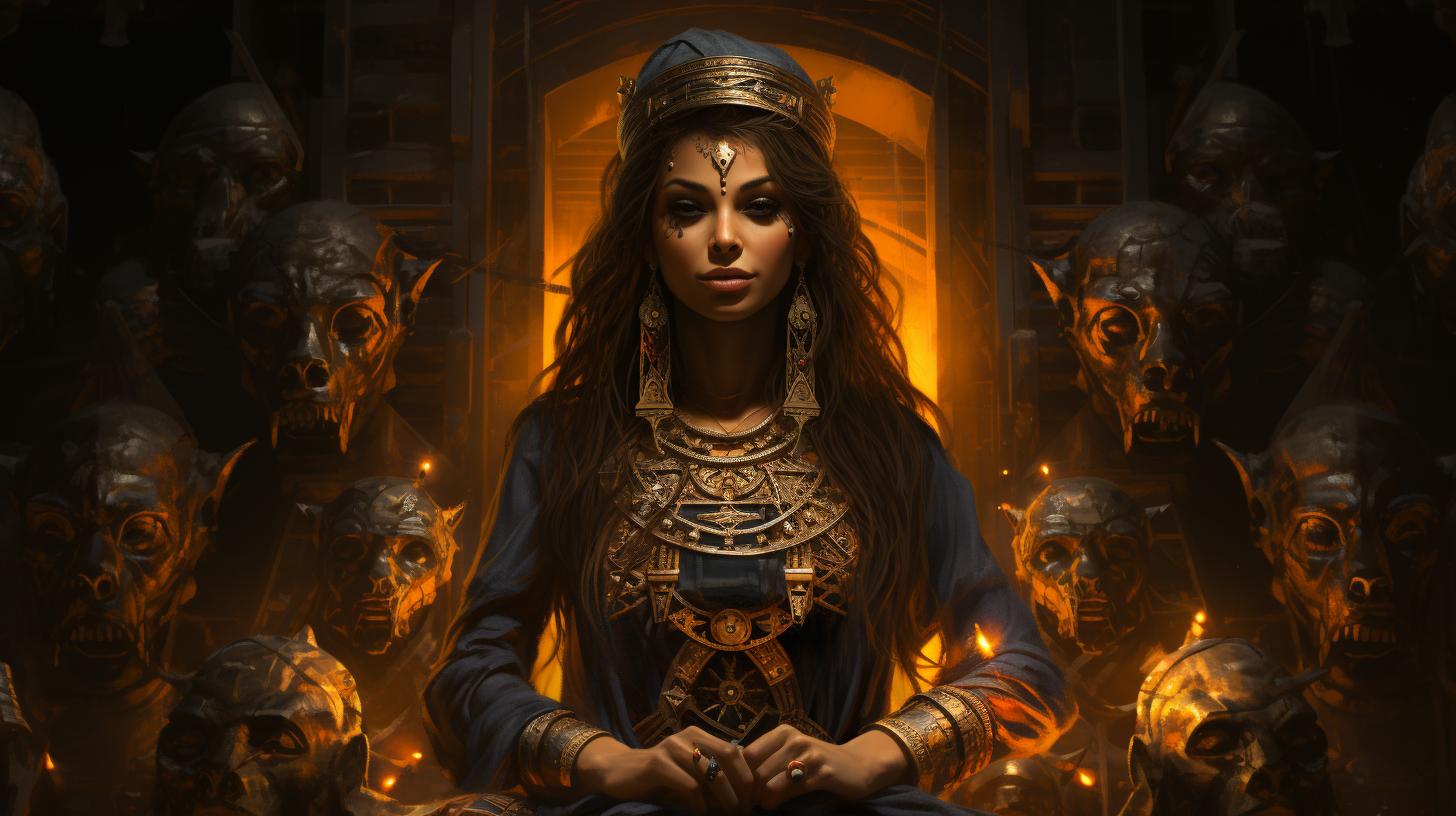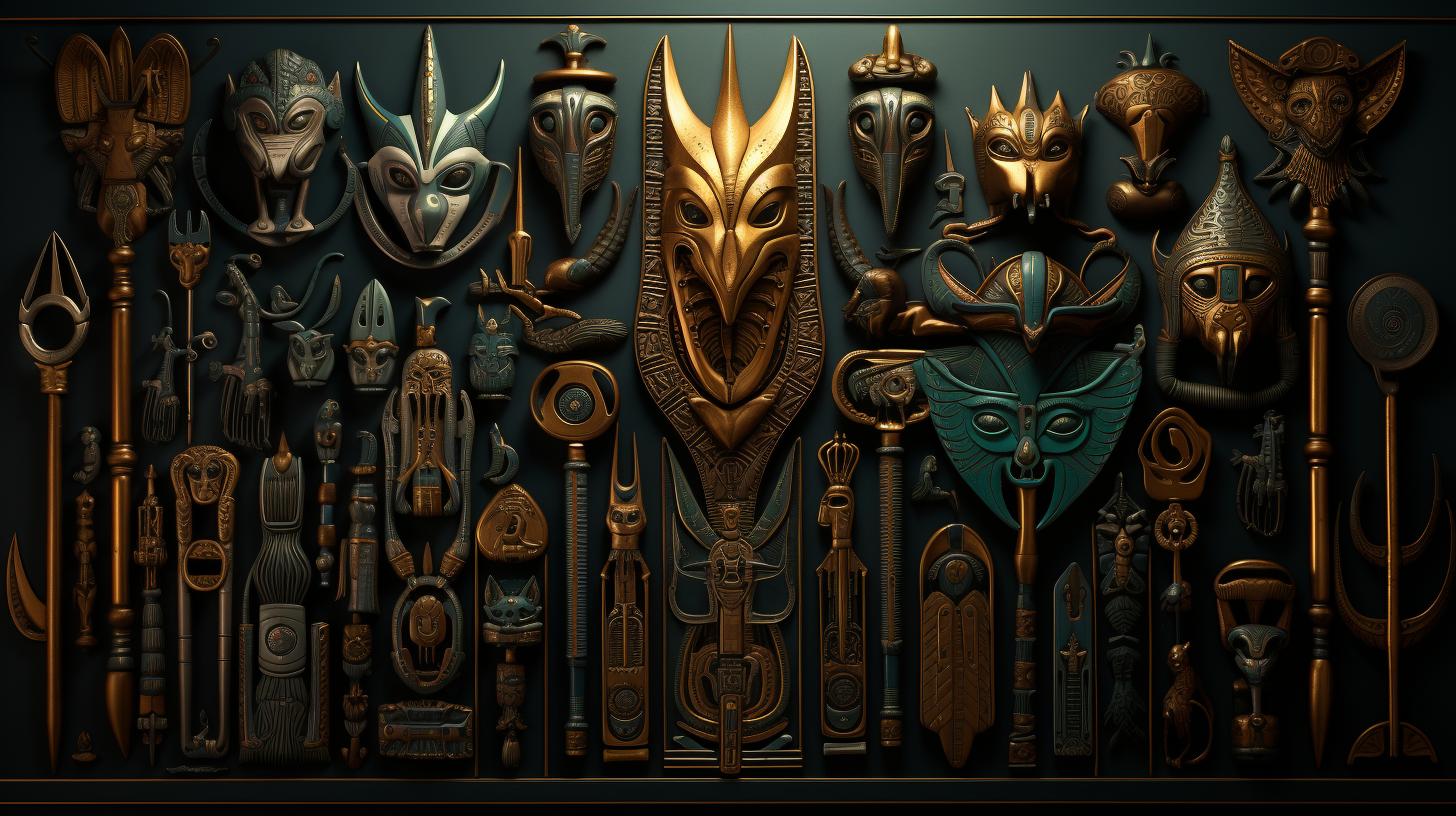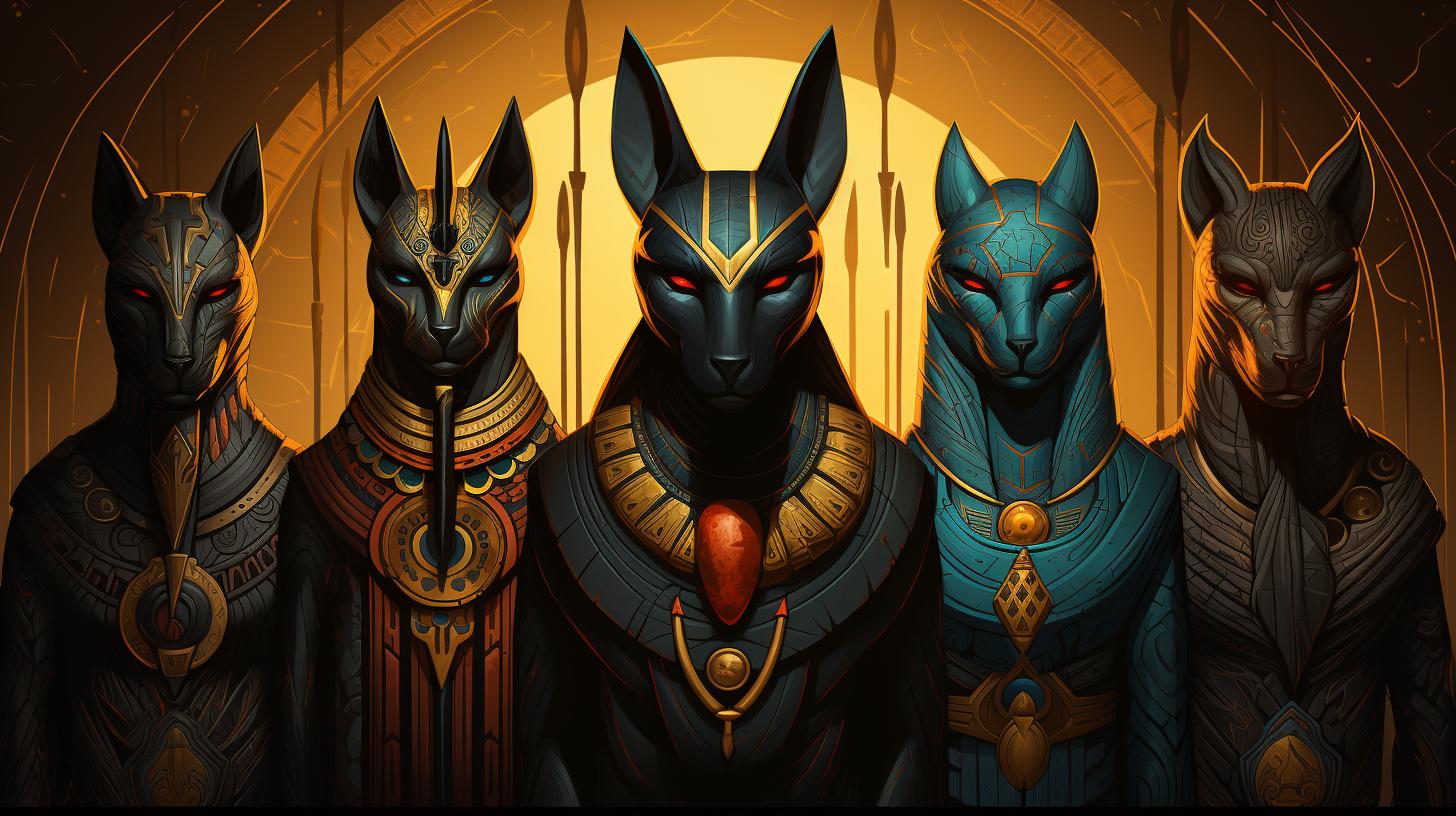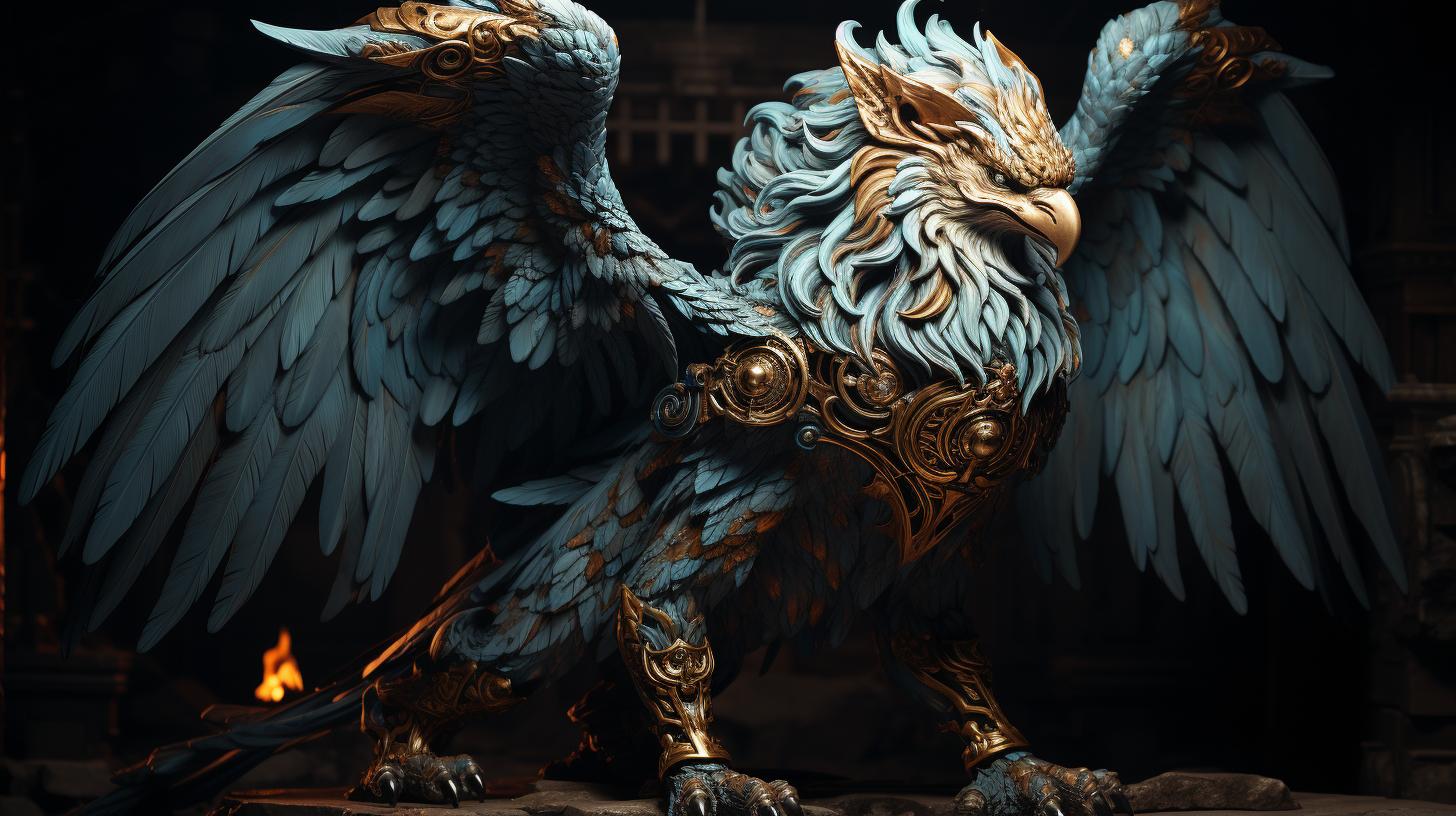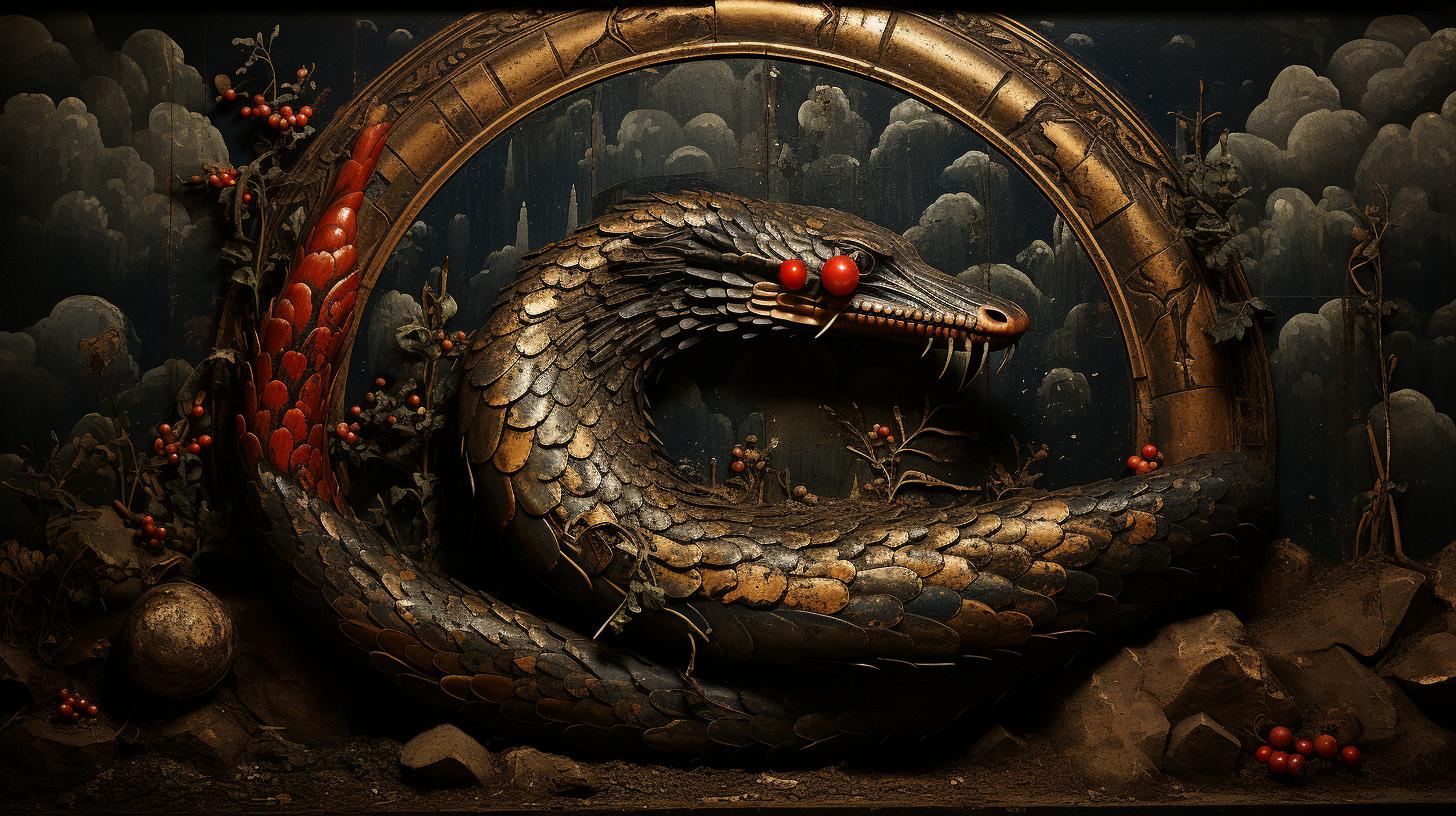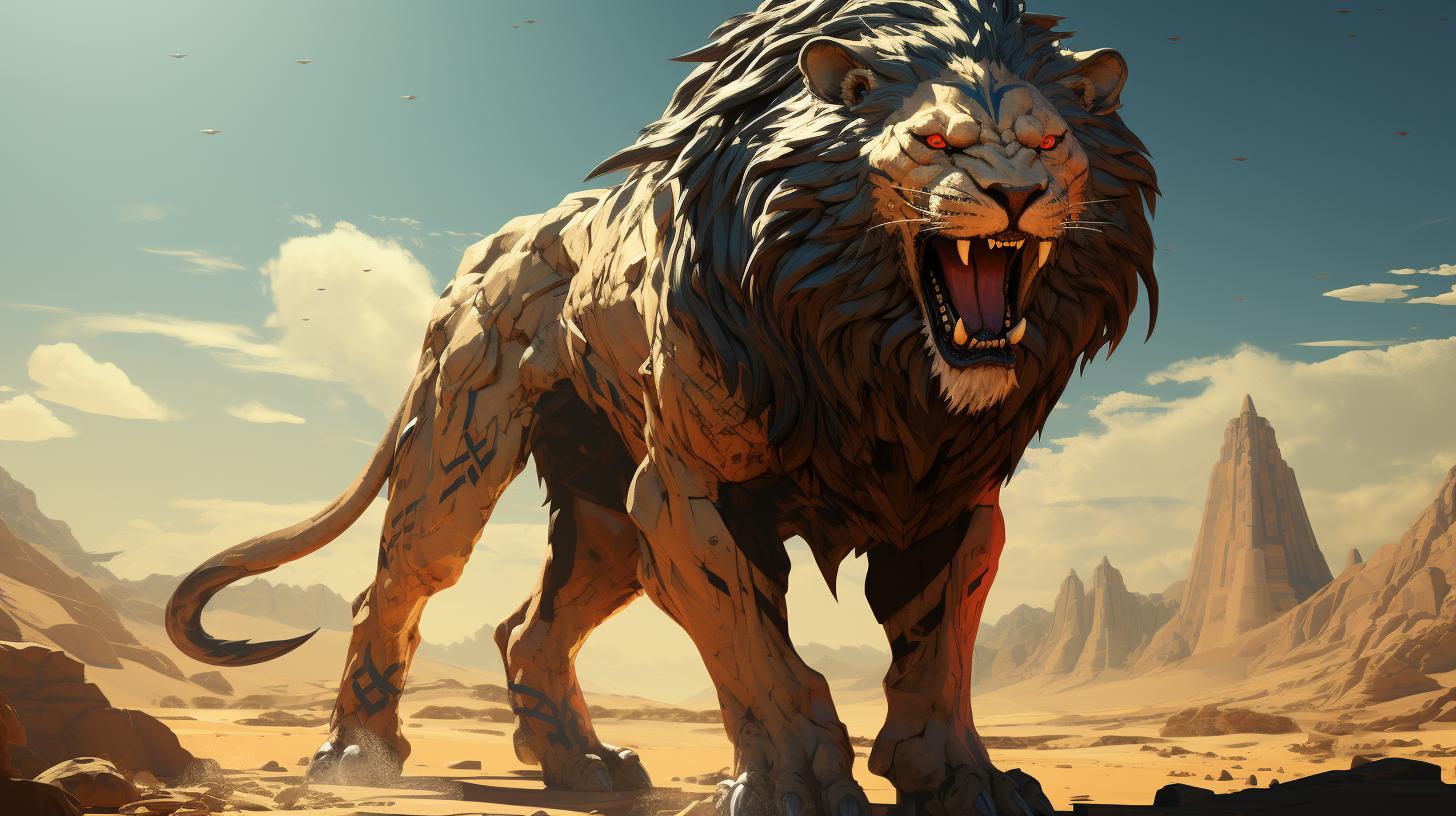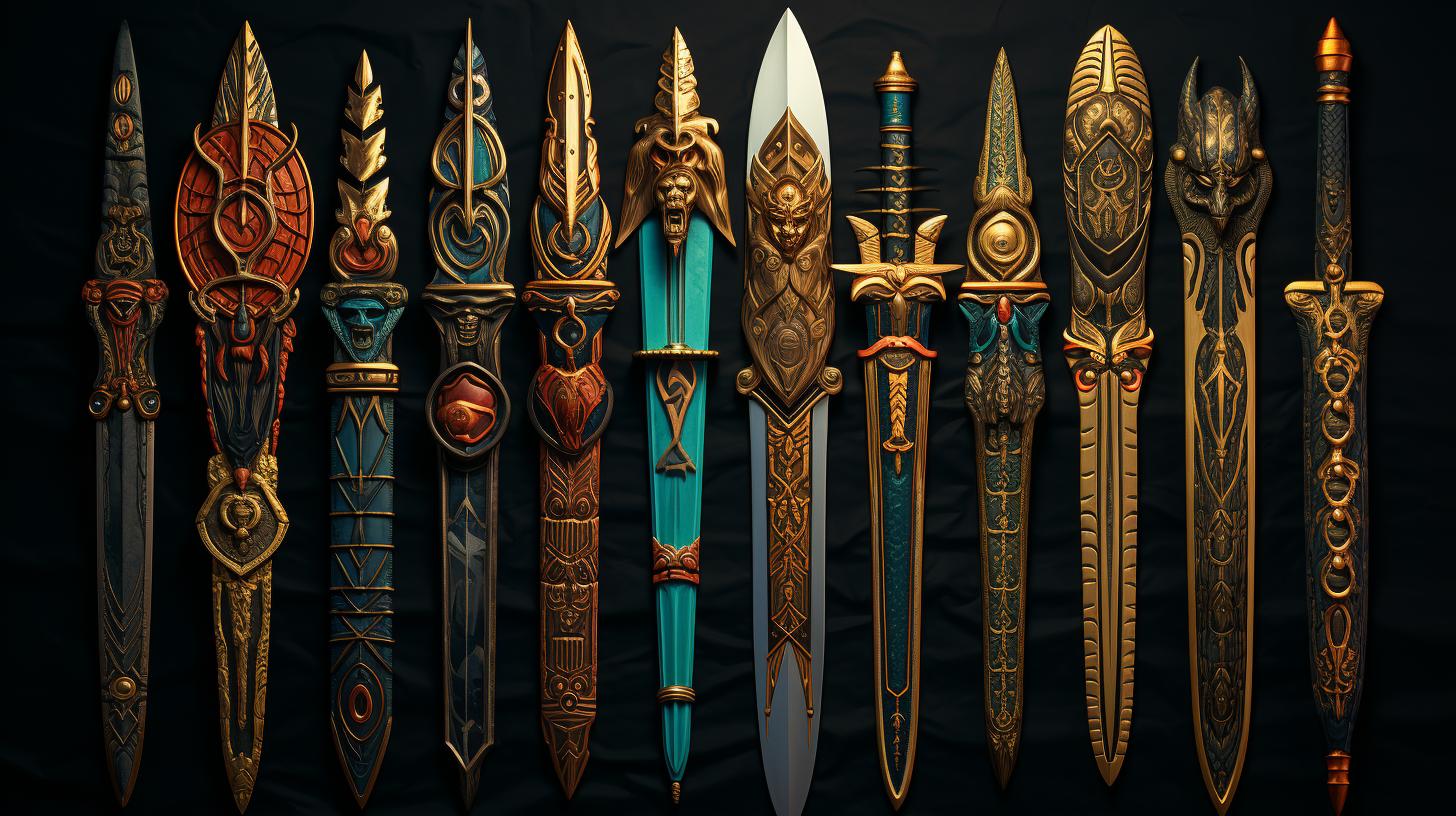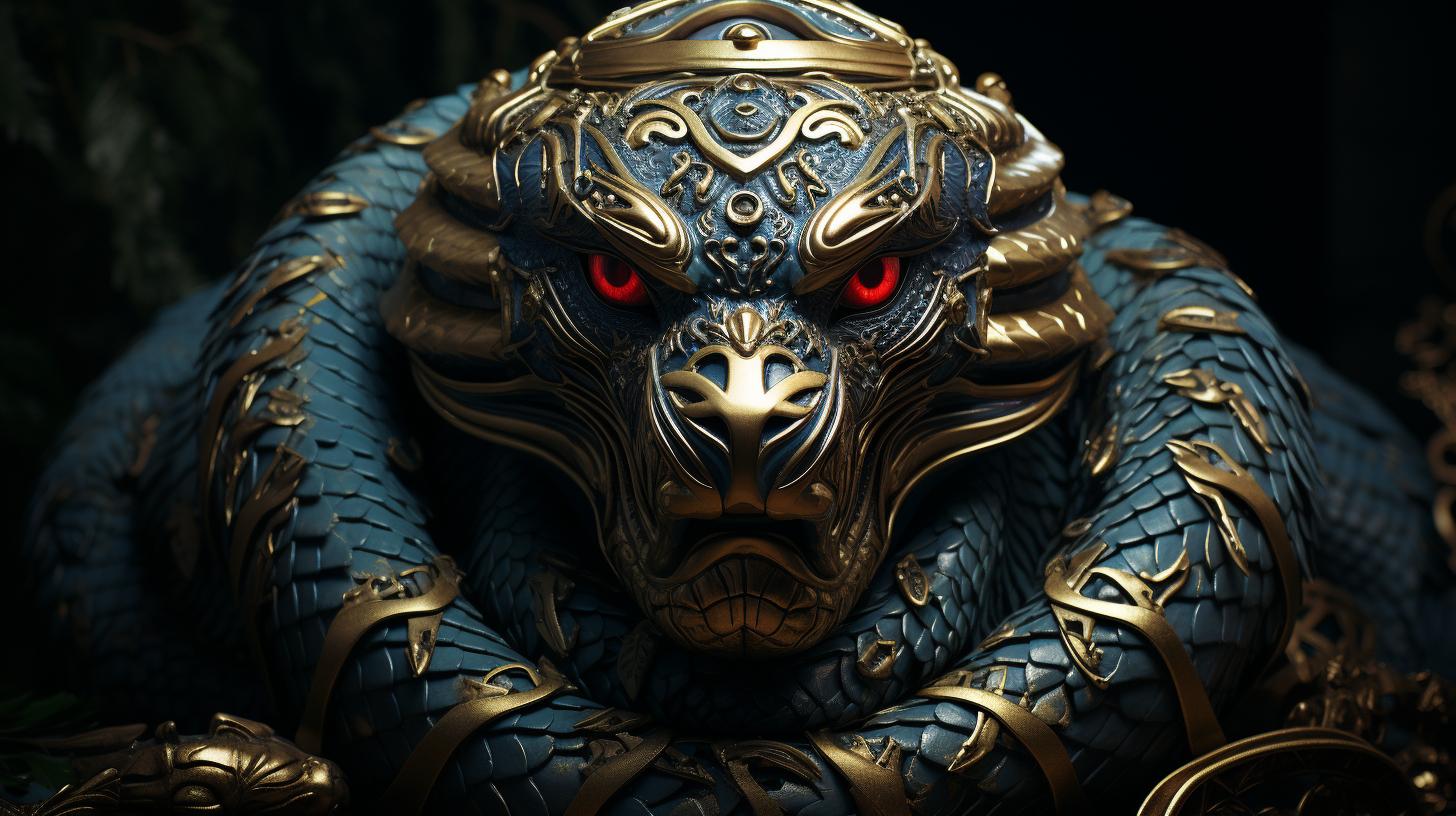Are Egyptian Gods Evil: Unveiling the Complex Nature of Ancient Deities
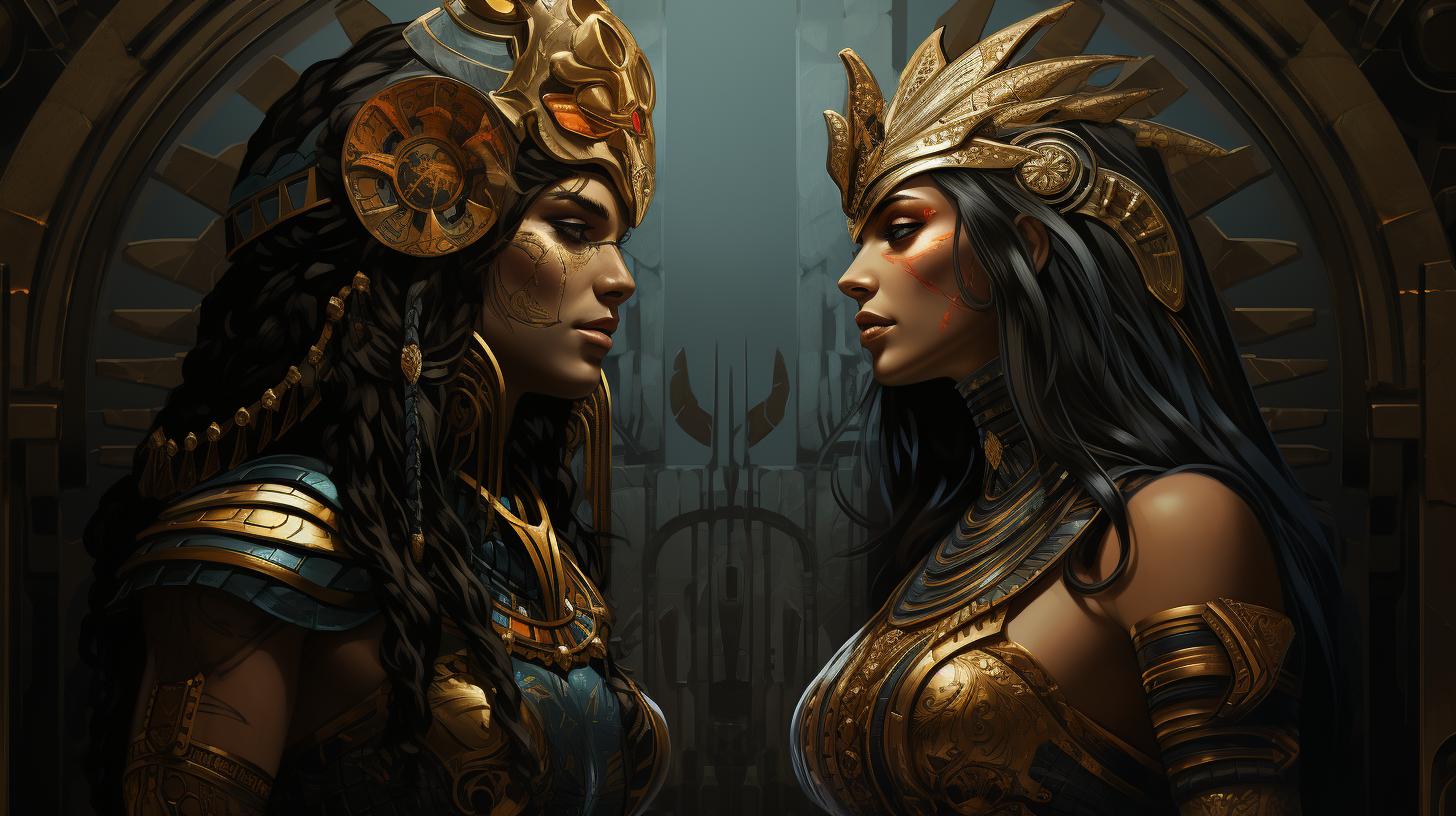
Egyptian Gods have long been a subject of fascination and intrigue. One particularly complex deity is Seth, known for his role in Egyptian mythology and religion. Associated with deserts, storms, chaos, and violence, Seth’s character elicits both fear and reverence.
He plays a pivotal part in the myth of Osiris, where his actions as an usurper and antagonist drive the narrative. The struggle for power between Seth and Horus further highlights the intricacies of this deity’s nature.
Additionally, Seth is revered as a protector of soldiers, hunters, and travelers, with associations in Egyptian astronomy as well. Through depictions in ancient art and influences on foreign mythologies, Seth’s legacy endures, shrouded in controversy.
Who was Seth?
Seth, also known as Set, was a prominent deity in ancient Egyptian mythology. He had a complex and multifaceted nature, associated with various aspects of the natural world and human experiences.
As a god of deserts, storms, and violence, Seth held a unique place among the Egyptian pantheon.
Often depicted as a creature with distinctive physical features, including a curved snout, square-tipped long ears, a thin forked tail, and a slim canine body, Seth’s representation varied throughout history.
In some depictions, he appeared as a human figure with a distinct head, while others portrayed him as a donkey or a man with a donkey’s head.
Seth was the son of Geb, the earth god, and Nut, the sky goddess.
He had siblings, including Osiris, Isis, and Nephthys, and he married his own sister, Nephthys. Additionally, Seth had children with both Nephthys and foreign goddesses Anat and Astarte.
While Seth’s character was not inherently evil, he played a pivotal role in the myth of Osiris. According to the myth, Seth murdered and dismembered his brother Osiris, causing great turmoil.
However, Seth’s actions were not without opposition. Osiris’ wife, Isis, managed to gather his scattered body parts and resurrect him with the assistance of Nephthys.
Seth’s complex nature extended beyond his role as a perpetrator in the Osiris myth.
He was also recognized as a protector of soldiers, hunters, and travelers who spent considerable time away from home. Seth was revered as the guardian of commercial caravans and the god of oases, often associated with prosperity and success.
Moreover, he was believed to sow discord and confusion among Egypt’s enemies, ensuring victory for the Egyptian army on the battlefield.
As the exploration of Egyptian mythology continues, Seth’s intricate character and significant contributions to ancient Egyptian religion and culture remain subjects of fascination and interpretation.
The Role of Seth in Egyptian Mythology
In Egyptian mythology, Seth occupies a prominent and complex role within the pantheon of gods. As the brother of Osiris, Isis, and Nephthys, Seth’s actions and interactions with other deities shape the narrative of Egyptian mythology.
Seth is often depicted as a god associated with deserts, storms, chaos, and violence. However, his role extends beyond these negative attributes. One of Seth’s significant functions is his role as a companion to the sun god Ra.
Together, they defend against the chaos embodied by Apep, the serpent of chaos, ensuring the harmony and order of the cosmos.
An intriguing aspect of Seth’s character is his connection with the concept of duality.
He represents the balance to Horus, who symbolizes the fertile land (known as the Black Land). Seth, on the other hand, embodies the arid deserts (known as the Red Land).
This duality between the two brothers contributes to the cyclical nature of Egyptian mythology, where harmony and turmoil are in a constant struggle.
The most well-known myth involving Seth is the story of Osiris. Seth, overcome by jealousy and desire for power, murders his brother Osiris, dismembering his body and scattering the pieces across Egypt.
This act of violence sets the stage for the eternal conflict between Seth and the rightful heir, Horus.
Despite his antagonistic actions, Seth is not solely portrayed as an evil deity.
In some contexts, he is revered as a protector, particularly of soldiers, hunters, and travelers. His role as the guardian of caravans and the Egyptian god of oases demonstrates his positive attributes, ensuring the success and safety of those venturing away from home.
Seth’s role in Egyptian mythology extends beyond just Egypt. He is associated with the planet Mercury in Egyptian astronomy, and his enigmatic representation as the “animal of Seth” showcases his distinct physical traits.
Depicted with a curved snout, square-tipped long ears, a slender forked tail, and a slim canine body, Seth’s imagery reflects the enigmatic and multifaceted nature of his character.
As we explore the complexities surrounding Seth’s role in Egyptian mythology, it becomes evident that he embodies both positive and negative aspects.
The interplay of chaos and order, violence and protection, sets him apart as a deity whose character cannot easily be classified as purely evil or purely good.
Seth’s Complex Nature and Characteristics
Seth, the Egyptian god, possesses a multifaceted nature defined by a myriad of characteristics.
As the deity associated with deserts, storms, chaos, and violence, Seth embodies both positive and negative elements in Egyptian mythology. His duality makes him an intriguing figure within the pantheon of gods.
One aspect of Seth’s character is his role as a reconciled combatant. Despite being known as the killer of Osiris, his own brother, Seth also plays a positive role as an ally of Ra.
In the journey of Ra’s barque, Seth aids in repelling the chaos serpent Apep, displaying his capacity to fight against the forces of disorder. This demonstrates Seth’s ability to switch between combatant and protector.
Another defining characteristic of Seth is his association with the Earth, particularly the Red Land or desert regions. While Horus represents the fertile Black Land, Seth balances this by ruling over the arid and barren territories.
This duality illustrates the necessary harmony between opposing forces for the well-being of the Egyptian kingdom.
Seth’s physical representation adds to the complexity of his nature. He is often depicted as an enigmatic creature known as the “animal of Set,” featuring a downward-curving snout, long square-tipped ears, a slim bifurcated tail with arrow-shaped tufts, and a slender canine body.
Additionally, Seth may be portrayed as a human figure with a distinct head or even as a donkey or a man with a donkey’s head.
Throughout Egyptian history, Seth’s character has been revered and viewed in different lights.
While he is infamous for his role in the murder of Osiris and the ensuing conflict with Horus, Seth is also regarded as a savior in certain periods. He is honored as the protector of soldiers, hunters, and travelers who spend extended periods away from home.
Additionally, Seth is believed to sow discord and confusion among Egypt’s enemies, thereby ensuring victory for the Egyptian army.
In conclusion, Seth’s complex nature encompasses a wide range of characteristics. While his association with chaos, violence, and the murder of Osiris has cast him in a negative light, Seth also plays important positive roles in Egyptian mythology.
His protective nature, connections to the desert, and ability to combat chaos showcase the intricate layers of Seth’s character within ancient Egyptian religion.
The Myth of Osiris and Seth’s Role
In Egyptian mythology, the myth of Osiris reveals the pivotal role of Seth as the antagonist and the catalyst for the central conflict.
According to the myth, Seth, fueled by envy and ambition, plotted to usurp the throne of his brother Osiris, knowing that only one could rule over Egypt. In a treacherous act, Seth trapped Osiris in a coffin, which he then cast into the Nile River, drowning Osiris and leaving Egypt bereft of its rightful ruler.
However, the myth of Osiris does not end with Osiris’s demise. Isis, wife and sister of Osiris, devotedly searched for his body and managed to find it.
Through her magic and powerful incantations, she resurrected Osiris, albeit temporarily, allowing him to participate in the conception of their son, Horus.
Upon reaching adulthood, Horus pledged to avenge his father’s murder and reclaim the throne from Seth.
A fierce battle ensued between Horus and Seth, representing not only the struggle for power but also the embodiment of order and chaos. The conflict between the two gods unfolded in various myths, depicting their intense rivalry and the ancient Egyptians’ belief in the perpetual battle between good and evil forces in the world.
The myth of Osiris and Seth’s role in it serves as a cautionary tale about ambition, envy, and the consequences of disrupting divine order. It reflects the Egyptian belief that balance and harmony were essential for the well-being of the kingdom and its people.
To delve deeper into the intricacies of Egyptian mythology and the complex characters of the gods, continue reading our related articles.
- Ancient Egyptian Mythology: Exploring the Gods and Goddesses
- Horus: The Resilient Avenger
- Osiris and Isis: The Divine Couple
- Nephthys: The Mysterious Goddess
Horus and Seth: The Struggle for Power
In Egyptian mythology, the rivalry between Horus and Seth is a tale filled with conflict and power struggles.
As the son of Osiris and Isis, Horus was destined to inherit the throne, but Seth had other plans. Upon the murder and dismemberment of his brother Osiris, Seth proclaimed himself ruler of Egypt, igniting a fierce battle for control.
The battles between Horus and Seth were not merely physical but also symbolic, representing the eternal struggle between order and chaos. Horus, embodying the rightful heir and the representation of the pharaoh, fought to restore harmony and stability to the land, while Seth aimed to maintain his usurped power, emphasizing violence and disruption.
- Horus exemplified virtues like justice, integrity, and righteousness.
- Seth, on the other hand, was often associated with chaos, violence, and unpredictability.
Throughout the mythological battles, Horus demonstrated his resilience, aided by his mother Isis and other gods such as Thoth. Their cunning strategies and magical powers helped tip the scales in Horus’s favor, leading to a series of encounters and confrontations that would ultimately decide the fate of Egypt.
The struggle between Horus and Seth represented more than just a contest for power; it also reflected the ongoing conflict between good and evil, order and disorder. It encapsulated the eternal cycle of Egyptian mythology, where the balance between opposing forces was constantly maintained.
Although Horus eventually emerged victorious, the story of the rivalry between Horus and Seth serves as a reminder of the complexities within Egyptian deities. It highlights the multifaceted nature of these gods and their roles in shaping the ancient Egyptian beliefs and worldview.
Seth’s Associations in Ancient Egyptian Religion
In ancient Egyptian religion, Seth held a significant place as a deity associated with various aspects of life and the natural world. While his complex nature often depicted him as a god of chaos and violence, Seth played crucial roles in several domains.
- Protector of Soldiers: Seth was revered as a guardian and protector of soldiers, offering his divine assistance in times of conflict and battles. It was believed that invoking Seth’s favor would ensure victory and protection on the battlefield.
- Patron of Hunters: Hunters sought Seth’s blessings as the deity who watched over their pursuits.
It was believed that Seth’s guidance and favor would lead to successful hunts and abundant animal resources.
- Guardian of Travelers: Seth was also considered the protector of those who embarked on long journeys, including traders and merchants.
Travelers would seek his aid to ensure safety and prosperity during their expeditions and encounters with foreign lands.
- God of Oases: The arid land of Egypt held numerous oases vital for survival.
Seth was specifically associated with these oases, believed to bring fertility and sustenance to these rare pockets of green amidst the desert.
- Disruptor of Enemies: In the realm of warfare, Seth was believed to sow discord and confusion among the enemies of Egypt, ensuring advantageous outcomes for the Egyptian army against their foes.
His involvement was perceived as a strategic advantage in achieving military success.
Seth’s associations in ancient Egyptian religion showcased his diverse and multi-faceted character. While his major role in mythology revolved around conflict and struggles for power, his reputation as a protective deity and his influence on various aspects of life cannot be ignored.
Seth as the Protector of Soldiers, Hunters, and Travelers
Seth, the Egyptian god known for his complex nature and roles in mythology, holds significance as the protector of soldiers, hunters, and travelers. While primarily recognized for his tumultuous past and conflicts, Seth is revered for his ability to safeguard those who spend extensive periods away from home.
In ancient Egypt, soldiers relied on the divine intervention of Seth to ensure their safety during battles. His association with violence and chaos made him a formidable ally on the battlefield, instilling fear in the hearts of their enemies.
Soldiers worshipped Seth, seeking his protection and guidance in their military endeavors.
Hunters also looked to Seth for assistance in their pursuit of game. Recognized as a deity who possessed exceptional abilities to navigate deserts and wild landscapes, Seth was believed to grant hunters enhanced tracking skills and favor their endeavors.
Hunters offered prayers and offerings to Seth, hoping for successful hunts and bountiful catches.
Furthermore, Seth’s role as the guardian of travelers was highly regarded in ancient Egypt. Whether embarking on trade journeys or venturing through treacherous terrains, individuals sought Seth’s divine protection to ensure their safe passage.
Caravans and groups of travelers would perform rituals and offerings to appease Seth, requesting his watchful presence throughout their expeditions.
As the god associated with deserts, storms, and foreigners, Seth’s realm extended beyond ordinary boundaries.
His unique responsibilities as the protector of soldiers, hunters, and travelers showcased his multifaceted nature within Egyptian mythology, illustrating his capacity to bring fortune and safety to those who sought his favor.
Seth’s Role in Egyptian Astronomy
In addition to his prominent role in Egyptian mythology and religion, Seth also holds significance in ancient Egyptian astronomy. He is often associated with the planet Mercury, known as the “star” of Seth.
This celestial connection further reflects the enigmatic and dualistic nature of the god Seth.
Depicted in ancient Egyptian star charts and astronomical texts, Seth’s representation as the animal-headed god provides insights into his astronomical associations.
He is often portrayed as an enigmatic creature, bearing distinct features such as a downward-curving snout, long square-tipped ears, a slender bifurcated tail with arrow-shaped hair tufts, and a slender canine body.
It is in this form that Set appears in the celestial realm, linking him to the cosmic forces and celestial bodies.
The association of Seth with the planet Mercury in ancient Egyptian astronomy reveals the perceived influence and power of this deity over celestial phenomena.
Just as Seth embodies chaos and disorder, the planet Mercury, with its unpredictable orbit and behavior, aligns with his character as the god of storms and deserts.
The intricate connection between Seth and astronomy in ancient Egypt highlights the multifaceted nature of this controversial deity.
While Seth’s infamy lies in his role as an antagonist and agent of chaos, his presence in Egyptian astronomy serves as a reminder of the complexity and diversity within the ancient pantheon.
Depictions of Seth in Ancient Egyptian Art
Ancient Egyptian art provides fascinating insights into the depictions of Seth, showcasing his unique and intriguing characteristics. Artists often portrayed Seth as a distinctive creature known as the animal of Set, featuring a downward-curved snout, long square-tipped ears, a slender and forked tail with arrow-shaped tufts of hair, and a slender canine body.
In some representations, Seth appears as a human with a distinct head, while in the Late Period, he is depicted as a donkey or a man with a donkey’s head.
The artistic representations of Seth serve to capture his enigmatic nature and associations with different aspects of Egyptian mythology.
Through intricate details and symbolism, these depictions convey Seth’s role as the lord of deserts, storms, and chaos. The animalistic features emphasize his connection to the wild and untamed forces of nature, reflecting his association with the untamed deserts.
Seth’s depictions in ancient Egyptian art also highlight his role as a significant character in the myth of Osiris. Artists depicted Seth’s pivotal act of murdering and mutilating his own brother, Osiris, as a central theme.
These artworks serve as visual narratives of the myth, often portraying the subsequent events, such as the resurrection of Osiris by the goddess Nephthys and the subsequent conflicts between Seth and Horus.
The contrasting representations of Seth, both as a fearsome antagonist responsible for chaos and violence and as a revered deity associated with protection and order, demonstrate the complexity of his character in ancient Egyptian mythology.
These artistic representations offer a visual exploration of Seth’s multifaceted nature, leaving viewers intrigued and captivated by the intricate details and symbolism incorporated into these ancient artworks.
Seth’s Influence on Foreign Cultures and Mythologies
Seth, the intriguing deity from ancient Egyptian mythology, has left a lasting impact beyond the borders of Egypt.
His complex nature and role in Egyptian mythology have inspired various cultures and mythologies around the world.
In Greek mythology, Seth became associated with the god Typhon, a monstrous figure associated with chaos and destruction.
The influence of Seth can also be seen in the Canaanite and Phoenician religions, where he was equated with the god Baal, the storm and fertility deity. This assimilation of Seth into different belief systems showcases his widespread recognition and influence.
- In Greek mythology, Seth’s counterpart, Typhon, was regarded as a symbol of volcanic eruptions and natural disasters.
- In Canaanite mythology, Seth’s association with Baal depicted him as a god of storms, rain, and fertility.
- In ancient Anatolian cultures, Seth’s influence resonated in the form of a storm deity known as Teshub.
Furthermore, Seth’s reputation as a chaotic and disruptive deity made its way into Judeo-Christian traditions.
In some interpretations, Seth became associated with the serpent in the Garden of Eden and represented temptation and evil.
Seth’s enduring presence in various mythologies reveals his complexity and the profound impact he had on cultures far beyond the reaches of ancient Egypt.
The intermingling of Seth’s characteristics with diverse belief systems demonstrates the wide recognition and interpretation of this enigmatic deity.
Unraveling the Controversies Surrounding Seth
Throughout ancient Egyptian mythology, the god Seth sparks numerous controversies and debates among scholars. His complex nature and actions have led to a diverse range of interpretations, with opinions varying on whether he should be considered purely evil or not.
Let’s delve into some of the controversies surrounding Seth and explore the different perspectives.
The Usurper
One of the key controversies revolves around Seth’s role as the usurper of Osiris, his own brother. According to the myth, Seth murdered and mutilated Osiris, leading to a heated struggle between them.
This act of violence and betrayal has painted Seth in a negative light, solidifying his reputation as a malevolent figure.
The Chaotic Force
Another source of controversy is Seth’s association with chaos and disorder. As a god of storms and deserts, he embodies a wild and unpredictable nature. Some argue that these characteristics make him inherently evil, as chaos is often seen as disruptive and destructive in a structured society.
Protector and Savior
Contrary to the traditional view of Seth as purely evil, there are those who interpret his actions differently. Seth is revered as a protector of soldiers, hunters, and travelers, providing assistance to those in need.
Some believe that his role as the guardian of caravans and his ability to sow discord among enemies of Egypt should be seen as acts of salvation rather than malevolence.
Symbolism and Dualism
The symbolism associated with Seth also adds to the controversies surrounding him.
As the lord of the desert, he serves as a counterpart to Horus, who represents fertile lands. This duality suggests a necessary balance in the Egyptian cosmology, where both chaos and order coexist.
It is argued that Seth’s seemingly negative actions are essential for the preservation of balance and harmony in the Egyptian religious framework.
In conclusion, the controversies surrounding Seth stem from his multifaceted nature and the varying interpretations of his actions.
While some view him as an unequivocally evil deity, others emphasize his protective attributes and symbolic significance within Egyptian mythology. The debates regarding Seth highlight the intricacies of ancient Egyptian belief systems and the complexities of evaluating divine characters from a human perspective.
Ancient Egyptian Mythology: Exploring the Gods and Goddesses
In Ancient Egyptian mythology, the gods and goddesses played a vital role in shaping their beliefs and cultural practices. Exploring the vast pantheon of Egyptian deities reveals a rich tapestry of divine beings with unique characteristics and roles.
One of the most intriguing figures in Egyptian mythology is Seth, the enigmatic god associated with deserts, storms, chaos, and violence. He is known for his complex nature and significant role in the myth of Osiris and the struggle for power with Horus.
However, Seth is just one among many fascinating Egyptian gods and goddesses.
Ra, the sun god, was revered as the creator and supreme deity, while Isis, the goddess of magic and fertility, possessed immense power and wisdom.
Exploring ancient Egyptian mythology provides insights into the worship of deities such as Thoth, the god of writing and knowledge, and Hathor, the goddess of love and motherhood.
These divine beings influenced various aspects of Egyptian life, from religious rituals to everyday practices.
Delve into the fascinating world of Ancient Egyptian mythology and discover the captivating stories of gods like Anubis, the jackal-headed god of embalming, and Bastet, the feline goddess of home and protection.
Uncover the significance of the Nile, considered a divine entity and a lifeline for Egyptian civilization, and learn about the rituals and festivals dedicated to honoring these deities.
Step back in time and immerse yourself in the mystique of Ancient Egyptian mythology.
Gain a deeper understanding of the gods and goddesses that shaped this ancient civilization and discover the intricate tapestry of beliefs that defined their world.
Horus: The Resilient Avenger
Horus, one of the central figures in Egyptian mythology, emerges as a resilient avenger in the epic struggle against Seth.
As the rightful heir to the throne, Horus endured immense challenges to claim his birthright and avenge his father’s death.
Throughout the mythological tales, Horus is depicted as a falcon-headed god, representing strength, vigilance, and justice.
His unwavering determination drives him to confront Seth, the usurper who murdered his father, Osiris.
The conflict between Horus and Seth is a testament to the eternal struggle between order and chaos, light and darkness.
Horus is propelled by his divine purpose to restore harmony and justice to the Egyptian kingdom, and his journey is marked by fierce battles and trials.
Horus’s resilience is exemplified by his unwavering commitment to vanquish Seth and restore his father’s legacy.
Despite Seth’s cunning tactics and attempts to undermine Horus, the avenger remains resolute and unyielding in his pursuit of justice.
Guided by his mother, Isis, and with the support of other deities such as Thoth, Horus emerges as a symbol of hope and righteousness in Egyptian mythology.
His bravery and determination inspire countless believers, echoing through the ages.
Osiris and Isis: The Divine Couple
The story of Osiris and Isis is a captivating tale within Egyptian mythology. These two deities form a divine couple whose love and devotion serve as a poignant symbol of power and resurrection.
Let us delve into their remarkable story and explore the significance of their roles in ancient Egypt.
The Divine Union
Osiris, the god of the afterlife and agriculture, was a just and revered ruler. Isis, his sister and wife, was the goddess of fertility, magic, and wisdom. Together, they embodied the balance and harmony that the Egyptian people sought in their lives.
The Betrayal
However, their idyllic existence was shattered by the treacherous actions of Osiris’ brother, Set. Consumed by envy and a thirst for power, Set devised a plan to murder Osiris and usurp his place as king.
Set’s malicious act led to immense grief and mourning throughout Egypt.
Isis’ Devotion
Isis, driven by her love for Osiris and her unwavering determination, embarked on a tireless quest to recover her husband’s broken body. With her extraordinary magical abilities, she traveled far and wide, collecting the scattered pieces of Osiris and reassembling them.
The Resurrection
Through her powerful spells and rituals, Isis ultimately succeeded in resurrecting Osiris. This miraculous act demonstrated her immense power and became a symbol of hope and renewal for the Egyptian people.
Legacy and Worship
The story of Osiris and Isis deeply touched the hearts of the Egyptian populace. Their divine union represented the eternal cycle of life, death, and rebirth. Temples dedicated to their worship were built throughout Egypt, and their cults thrived for centuries, offering solace, guidance, and protection.
A Symbol of Love and Resilience
The myth of Osiris and Isis resonates even today, reminding us of the transformative power of love, devotion, and the ability to overcome immense challenges. Their story inspires us to believe in the potential for rebirth and renewal in our own lives.
Nephthys: The Mysterious Goddess
Nephthys, the enigmatic goddess of ancient Egyptian mythology, remains an intriguing figure with her unique qualities and connections within the divine pantheon. As the sister of Isis, Osiris, and Seth, Nephthys possesses her own distinct role and symbolism.
Often depicted as a protective goddess, Nephthys is associated with mourning and transformation. She is closely linked to death and the afterlife, serving as a guardian of the deceased on their journey to the realm of Osiris. Nephthys is often portrayed as a comforting presence, providing solace and guidance to those entering the underworld.
Unlike her more prominent counterparts, Nephthys embodies subtlety and mystery. She is often seen as a symbol of concealed emotions and hidden knowledge. Nephthys represents the unseen aspects of life and holds the secrets that lie beneath the surface.
Furthermore, Nephthys plays a vital role in the resurrection of Osiris. Alongside her sister, Isis, she aids in the reconstruction of Osiris’ body, enabling his rebirth and subsequent ascension as the ruler of the underworld.
This act of divine intervention showcases Nephthys’ importance as a facilitator of rebirth and renewal.
While less prominent in Egyptian mythology compared to other deities, Nephthys’ presence is essential.
As a counterbalance to the more widely recognized figures, she brings a sense of balance and completeness to the pantheon.
- Significance of Nephthys:
Exploring the depths of Nephthys’ character reveals her intriguing and multifaceted nature, underscoring the nuanced complexities of Egyptian mythology and the role of divine beings within it.
.











